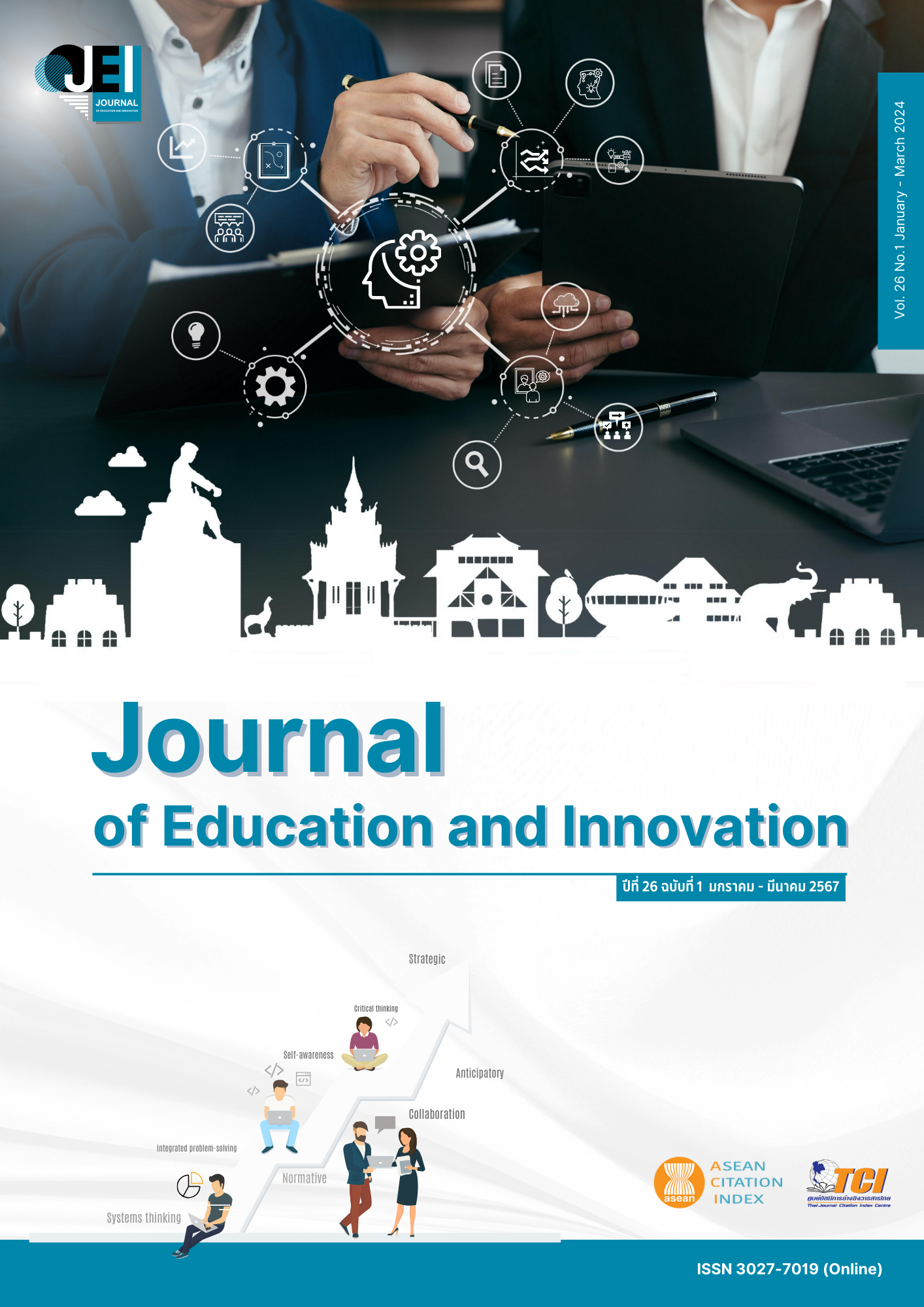THE RESULTS OF USING A LEARNING ACTIVITY BASE ON THE CONCEPT OF STEAM EDUCATION TO DEVELOP LEARNING ACHIEVEMENT AND CREATIVE ABILITY OF 10TH GRADE STUDENTS
Main Article Content
Abstract
The purposes of this research were to study the results of using a learning activity base on the concept of STEAM Education to towards learning achievement and creative ability of 10th grade students. The action research consists of 3 cycles, each cycle consisting of 1) Plan, 2) Action, 3) Observation, and 4) Reflection. The target group of this research consisted of 37 tenth grade students. The research instruments consisted of 1) the lesson plans based on the STEAM Education approach, 2) physics achievement test on linear motion, force and Newton’s laws of motion , and two-dimensional motion, 3) the achievement quizzes at the end of each cycle, and 4) the assessment form for work creative ability. The data were analyzed by mean, standard deviation, relative gain score, and qualitative analysis. These were the results of this research : 1) The tenth grade student’s learning achievements based on the STEAM Education approach had a relative gain score of 51.30 percent, which was a high-level development. 2) The tenth grade student’s work creative ability based on the STEAM Education approach had a work creative ability score of 76.46 percent, which was a good level.
Article Details

This work is licensed under a Creative Commons Attribution-NonCommercial-NoDerivatives 4.0 International License.
The owner of the article does not copy or violate any of its copyright. If any copyright infringement occurs or prosecution, in any case, the Editorial Board is not involved in all the rights to the owner of the article to be performed.
References
Badriyah, N. L., Anekawati, A., & Azizah, L. F. (2020). Application of PjBL with brain-based STEAM approach to improve learning achievement of students. Jurnal Inovasi Pendidikan IPA, 6(1), 88-100.
Choi, Y., Yang, J. H., & Hong, S. H. (2016). The effects of smart media based STEAM program of' Chicken Life Cycle'on academic achievement, Scientific process skills and affective domain of elementary school students. Journal of Korean Elementary Science Education, 35(2), 166-180.
Jampong, M. (2016). Development of training package for work creation through steam education approach on energy around us (Master thesis). Pathum Thani: Rajamangala University of Technology Thanyaburi.
Kanjanawasee, S. (2013). Classical test theory (7th ed.). Bangkok: Chulalongkorn University Press.
Khammani, T. (2005). Teaching techniques: Knowledge for effective learning process. Bangkok: Chulalongkorn University.
Kemmis, S., & McTaggart, R. (1988). The action research planner (3rd ed.). Geelong, Victoria: Deakin University Press.
Lee, H., Bae, T., & Lee, H. (2016). Development and application of the scientific inquiry-based STEAM Education program about earthquakes. Journal of the Korean Earth Science Society, 37(7), 476-488.
Ministry of Education. (2017). The National Education Plan B.E. 2560-2579 (2017-2036). Bangkok: Prigwhan Graphic.
Office of the National Education Commission. (2019). Evaluation Guide for development of Learning Activities “Teach less, learn more”. Retrieved April 25, 2018, from https://www.opec.go.th/ckfinder/userfiles/files/5(1).pdf
Orapiriyakul, S. (2019). STEAM Education: Innovative Education Integrated into Learning Management. Journal of Research and Curriculum Development, 9(1), 1-16.
Phengnoi, D., & Boonsom, N. (2021). The Development of creative problem solving and science working creation abilities in fifth grade students by learning activities manage education base on the concept of STEAM Education (Doctoral dissertation). Nakhon Pathom: Silpakorn University.
PISA Thailand. (2019). Focus issue from PISA: Issue 48 (December 2019). Retried December 1, 2022, from https://pisathailand.ipst.ac.th/issue-2019-48/
Radziwill, N. M., Benton, M. C., & Moellers, C. (2015). "From STEM to STEAM: Reframing What it Means to Learn". The STEAM Journal, 2(1), 3.
Riley, S. (2012). Common core and arts integration assessment rubric. Retrieved from
https://educationcloset.com/2012/09/21/common-core-and-arts-integration-assessmentrubric/
Riley, S. M. (2014). No permission required: Bringing STEAM to life in K-12 schools. Westminster, Maryland: Visionyst Press.
Santipaiboon, J. (2018). Learner’s Development Activities by STEAM and Productivity Based learning to Enhance the Process Skills and Creative Ability in Third Grade Students. Journal of Education Studies, 46(3), 69-85.
Sriboon, S., & Pongen, W. (2019). The Learning Outcomes of STEAM Education based on Problem Based Learning to Developing Mathematical Skills and Process for Seventh Grade Students. Journal of Education Studies, 47(1), 526-543.
The Institute for the Promotion of Teaching Science and Technology. (2019). Physics 1 (3rd ed.). Bangkok: Chulalongkorn University Press.
Wells, J., Henderson, R., Stewart, J., Stewart, G., Yang, J., & Traxler, A. (2019). Exploring the structure of misconceptions in the Force Concept Inventory with modified module analysis. Physical Review Physics Education Research, 15(2), 020122.
Yakman, G. (2008). STEAM Education: An overview of creating a model of integrative education. Retrieved April 24, 2018, from https://www.academia.edu/8113795/


